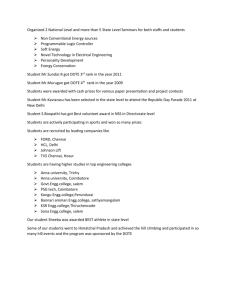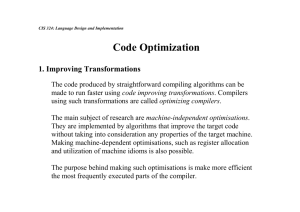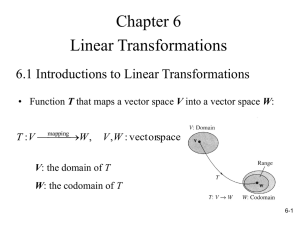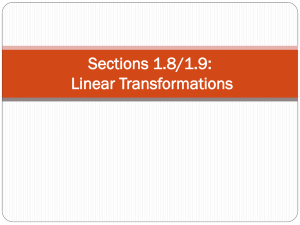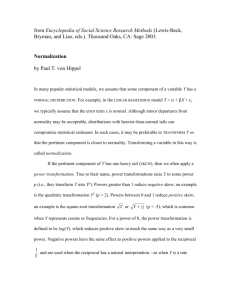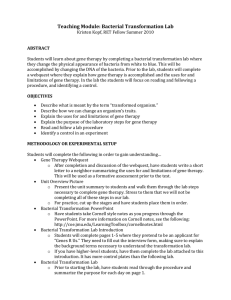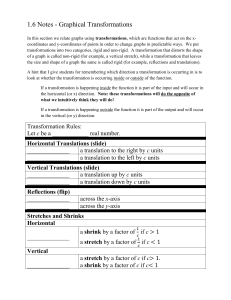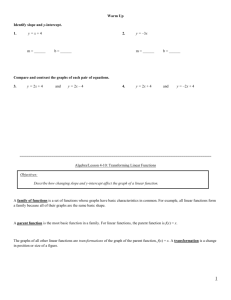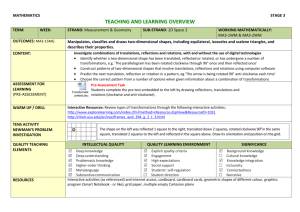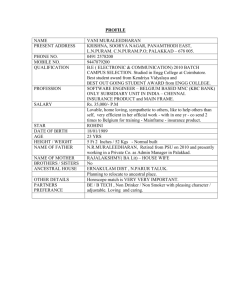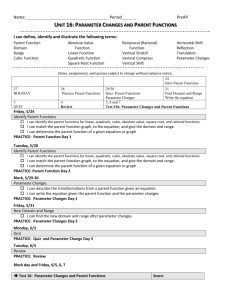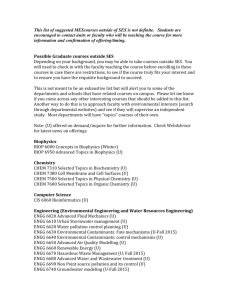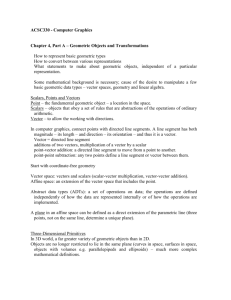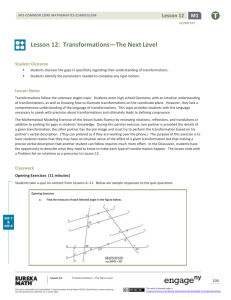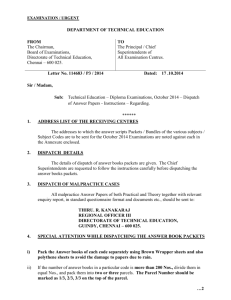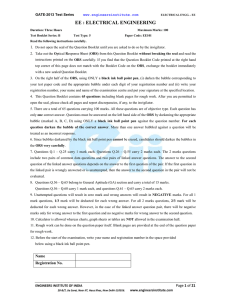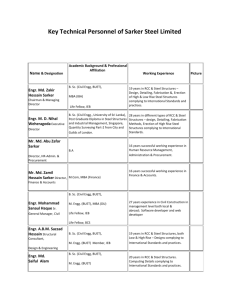File
advertisement
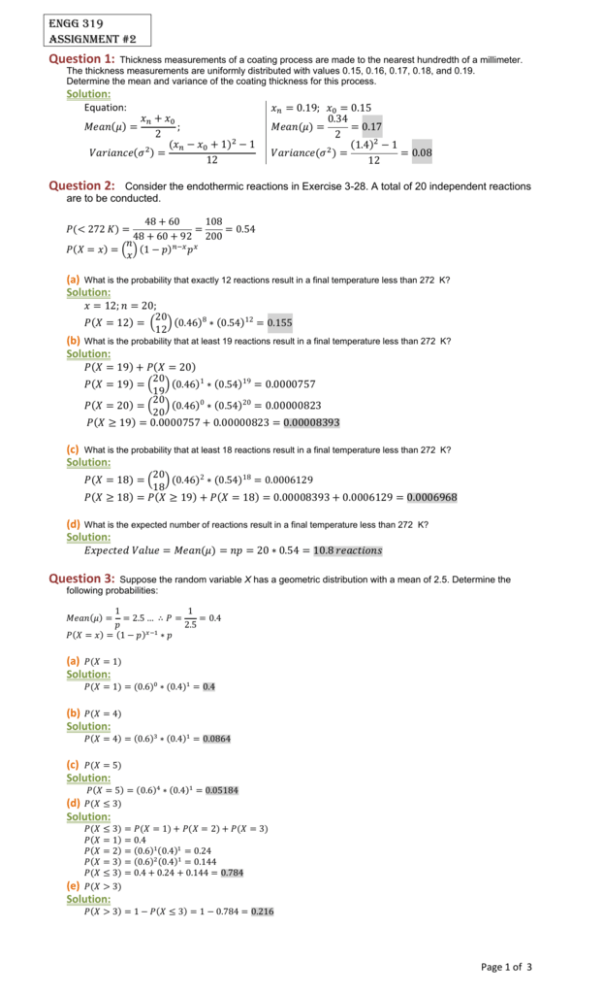
ENGG 319 Assignment #2 Question 1: Thickness measurements of a coating process are made to the nearest hundredth of a millimeter. The thickness measurements are uniformly distributed with values 0.15, 0.16, 0.17, 0.18, and 0.19. Determine the mean and variance of the coating thickness for this process. Solution: Equation: 𝑥𝑛 + 𝑥0 𝑀𝑒𝑎𝑛(𝜇) = ; 2 (𝑥𝑛 − 𝑥0 + 1)2 − 1 𝑉𝑎𝑟𝑖𝑎𝑛𝑐𝑒(𝜎 2 ) = 12 𝑥𝑛 = 0.19; 𝑥0 = 0.15 0.34 𝑀𝑒𝑎𝑛(𝜇) = = 0.17 2 (1.4)2 − 1 𝑉𝑎𝑟𝑖𝑎𝑛𝑐𝑒(𝜎 2 ) = = 0.08 12 Question 2: Consider the endothermic reactions in Exercise 3-28. A total of 20 independent reactions are to be conducted. 48 + 60 108 𝑃(< 272 𝐾) = = = 0.54 48 + 60 + 92 200 𝑛 𝑃(𝑋 = 𝑥) = ( ) (1 − 𝑝)𝑛−𝑥 𝑝 𝑥 𝑥 (a) What is the probability that exactly 12 reactions result in a final temperature less than 272 Solution: K? 𝑥 = 12; 𝑛 = 20; 20 𝑃(𝑋 = 12) = ( ) (0.46)8 ∗ (0.54)12 = 0.155 12 (b) What is the probability that at least 19 reactions result in a final temperature less than 272 Solution: K? 𝑃(𝑋 = 19) + 𝑃(𝑋 = 20) 20 𝑃(𝑋 = 19) = ( ) (0.46)1 ∗ (0.54)19 = 0.0000757 19 20 𝑃(𝑋 = 20) = ( ) (0.46)0 ∗ (0.54)20 = 0.00000823 20 𝑃(𝑋 ≥ 19) = 0.0000757 + 0.00000823 = 0.00008393 (c) What is the probability that at least 18 reactions result in a final temperature less than 272 Solution: K? 20 𝑃(𝑋 = 18) = ( ) (0.46)2 ∗ (0.54)18 = 0.0006129 18 𝑃(𝑋 ≥ 18) = 𝑃(𝑋 ≥ 19) + 𝑃(𝑋 = 18) = 0.00008393 + 0.0006129 = 0.0006968 (d) What is the expected number of reactions result in a final temperature less than 272 Solution: K? 𝐸𝑥𝑝𝑒𝑐𝑡𝑒𝑑 𝑉𝑎𝑙𝑢𝑒 = 𝑀𝑒𝑎𝑛(𝜇) = 𝑛𝑝 = 20 ∗ 0.54 = 10.8 𝑟𝑒𝑎𝑐𝑡𝑖𝑜𝑛𝑠 Question 3: Suppose the random variable X has a geometric distribution with a mean of 2.5. Determine the following probabilities: 1 1 = 2.5 … ∴ 𝑃 = = 0.4 𝑝 2.5 𝑥−1 𝑃(𝑋 = 𝑥) = (1 − 𝑝) ∗𝑝 𝑀𝑒𝑎𝑛(𝜇) = (a) 𝑃(𝑋 = 1) Solution: 𝑃(𝑋 = 1) = (0.6)0 ∗ (0.4)1 = 0.4 (b) 𝑃(𝑋 = 4) Solution: 𝑃(𝑋 = 4) = (0.6)3 ∗ (0.4)1 = 0.0864 (c) 𝑃(𝑋 = 5) Solution: 𝑃(𝑋 = 5) = (0.6)4 ∗ (0.4)1 = 0.05184 𝑃(𝑋 ≤ 3) (d) Solution: 𝑃(𝑋 𝑃(𝑋 𝑃(𝑋 𝑃(𝑋 𝑃(𝑋 𝑃(𝑋 ≤ 3) = 𝑃(𝑋 = 1) + 𝑃(𝑋 = 2) + 𝑃(𝑋 = 3) = 1) = 0.4 = 2) = (0.6)1 (0.4)1 = 0.24 = 3) = (0.6)2 (0.4)1 = 0.144 ≤ 3) = 0.4 + 0.24 + 0.144 = 0.784 > 3) (e) Solution: 𝑃(𝑋 > 3) = 1 − 𝑃(𝑋 ≤ 3) = 1 − 0.784 = 0.216 Page 1 of 3 ENGG 319 Assignment #2 Question 4: In a clinical study, volunteers are tested for a gene that has been found to increase the risk for a disease. The probability that a person carries the gene is 0.1. 𝑝 = 0.1 𝑃(𝑋 = 𝑥) = ( 𝑥 − 1 (1 ) − 𝑝)𝑥−𝑟 𝑝𝑟 𝑟−1 (a) What is the probability four or more people will have to be tested before two with the gene are detected? Solution: 𝑃(𝑋 ≥ 4) = 1 − 𝑃(𝑋 < 4) = 𝑃(𝑋 = 1) + 𝑃(𝑋 = 2) + 𝑃(𝑋 = 3) 𝑠𝑖𝑛𝑐𝑒 𝑤𝑒 𝑛𝑒𝑒𝑑 𝑡𝑤𝑜 𝑠𝑢𝑐𝑐𝑒𝑠𝑠; 𝑃(𝑋 ≥ 4) = 1 − 𝑃(𝑋 < 4) = 𝑃(𝑋 = 2) + 𝑃(𝑋 = 3) 1 𝑃(𝑋 = 2) = ( ) ∗ (0.9)0 (0.1)2 = 0.01 1 2 𝑃(𝑋 = 3) = ( ) (0.9)1 (0.1)2 = 0.018 1 𝑃(𝑋 ≥ 4) = 1 − 0.028 = 0.972 (b) How many people are expected to be tested before two with the gene are detected? Solution: 𝐸𝑥𝑝𝑒𝑐𝑡𝑒𝑑 𝑁𝑢𝑚𝑏𝑒𝑟 = 𝑀𝑒𝑎𝑛(𝜇) = 𝑟 2 = = 20 𝑝𝑒𝑜𝑝𝑙𝑒 𝑝 0.1 Question 5: The analysis of results from a leaf transmutation experiment (turning a leaf into a petal) is summarized by type of transformation completed: Total Color Transformation Yes No Total Textural Transformation Yes No 243 26 13 18 A naturalist randomly selects three leaves from this set, without replacement. Determine the following probabilities. 𝑁−𝐾 𝐾 )( ) 𝑃(𝑋 = 𝑥) = 𝑛 − 𝑥 𝑥 𝑁 ( ) 𝑛 𝑁 = 300; 𝑛 = 3 ( (a) Exactly one has undergone both types of transformations. Solution: 𝐾 = 243; 𝑥 = 1 57 243 ( )( ) 1 = 0.0871 𝑃(𝑋 = 1) = 2 300 ( ) 3 (b) At least one has undergone both transformations. Solution: 𝑃(𝑋 ≥ 1) = 1 − 𝑃(𝑋 < 1) = 1 − 𝑃(𝑋 = 0) 57 243 ( )( ) 0 = 0.006568 𝑃(𝑋 = 0) = 3 300 ( ) 3 𝑃(𝑋 ≥ 1) = 1 − 0.006568 = 0.99342 (c) Exactly one has undergone one but not both transformations. Solution: 𝐾 = 26 + 13 = 39; 𝑥 = 1 261 39 ( )( ) 1 = 0.297 𝑃(𝑋 = 1) = 2 300 ( ) 3 (d) At least one has undergone at least one transformation. Solution: 𝐾 = 26 + 13 + 243 = 282; 𝑥 ≥ 1 𝑃(𝑋 ≥ 1) = 1 − 𝑃(𝑋 < 1) = 1 − 𝑃(𝑋 = 0) 18 282 ( )( ) 0 = 0.0001832 𝑃(𝑋 = 0) = 3 300 ( ) 3 𝑃(𝑋 ≥ 1) = 1 − 0.0001832 = 0.9998 Question 6: Assume the number of errors along a magnetic recording surface is a Poisson random variable with a mean of one error every 105 bits. A sector of data consists of 4096 eight-bit bytes. Page 2 of 3 ENGG 319 Assignment #2 (a) What is the probability of more than one error in a sector? Solution: 𝑒 −𝜆𝑡 (𝜆𝑡)𝑥 𝑥! 4096 ∗ 8 𝜆 = 𝑛𝑝 = = 0.32768; 𝑥 > 1; 105 𝑃(𝑋 > 1) = 1 − 𝑃(𝑋 ≤ 1) = 1 − 𝑃(𝑋 = 0) − 𝑃(𝑋 = 1) 𝑒 −0.32768 ∗ 0.327680 𝑃(𝑋 = 0) = = 0.72059 0! 𝑒 −0.32768 ∗ 0.327680 𝑃(𝑋 = 1) = = 0.23612 0! 𝑃(𝑋 > 1) = 1 − 0.72059 − 0.23612 = 0.04328 𝑓(𝑥) == (b) What is the mean number of sectors until an error is found? Solution: 𝑃(𝑋 ≥ 1) = 1 − 𝑃(𝑋 < 1) = 1 − 𝑃(𝑋 = 0) 𝑒 −0.32768 ∗ 0.327680 𝑃(𝑋 = 0) = = 0.72059 0! 𝑃(𝑋 ≥ 1) = 1 − 0.72059 = 0.27941 𝑆𝑖𝑛𝑐𝑒 𝑤𝑒 𝑎𝑟𝑒 𝑙𝑜𝑜𝑘𝑖𝑛𝑔 𝑓𝑜𝑟 𝑡ℎ𝑒 𝑚𝑒𝑎𝑛 𝑜𝑓 𝑢𝑛𝑡𝑖𝑙 1𝑠𝑡 𝑠𝑢𝑐𝑐𝑒𝑠𝑠 1 1 𝑚𝑒𝑎𝑛(𝜇) = = = 3.57897 𝑆𝑒𝑐𝑡𝑜𝑟𝑠 𝑃(𝑋 ≥ 1) 0.27941 Page 3 of 3

